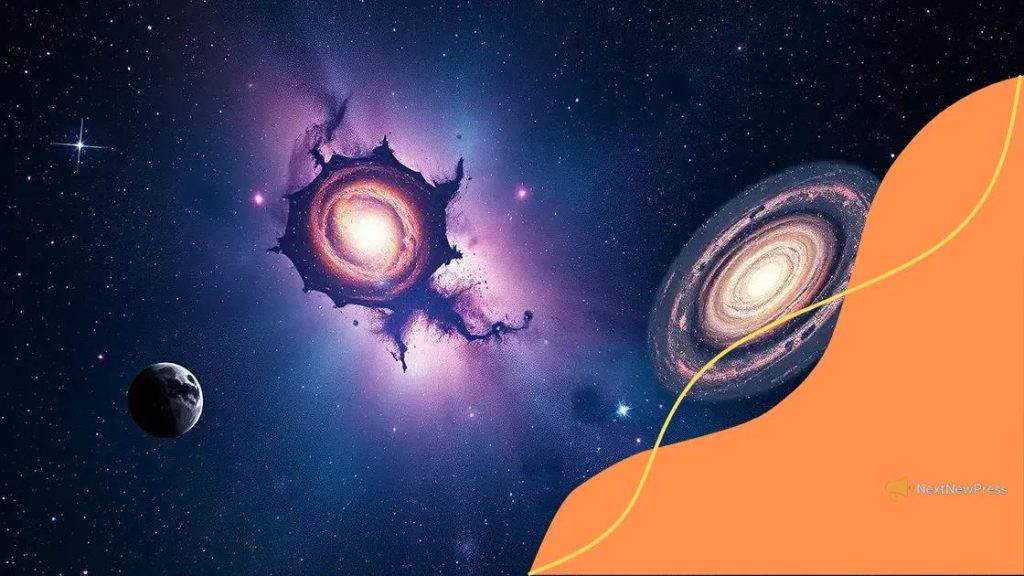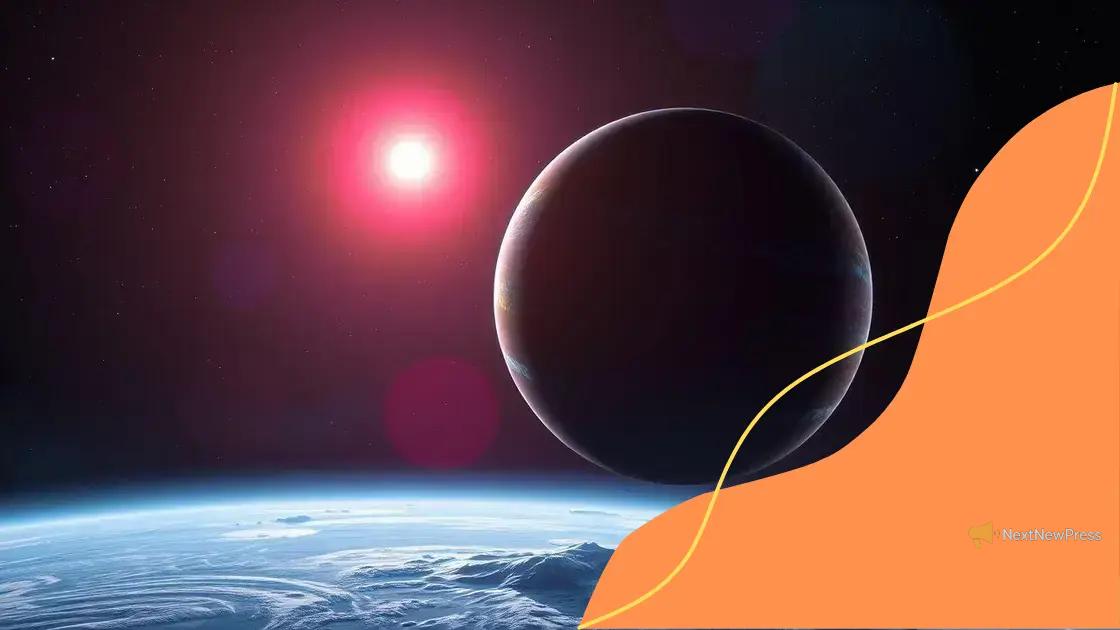Latest astrophysics and cosmology discoveries: what’s new?

Cosmic inflation is a theory proposing a rapid expansion of the universe after the Big Bang, explaining its uniformity, flatness, and the seeds for galaxy formation through density fluctuations.
Latest astrophysics and cosmology discoveries are continually pushing the boundaries of what we know about our universe. Whether it’s uncovering the mysteries of dark matter or exploring far-off exoplanets, there’s always something new and exciting to learn. Ready to dive into the latest findings? Let’s explore!
Understanding dark matter and dark energy
Dark matter and dark energy are intriguing concepts in the field of astrophysics. To grasp dark matter, we need to recognize that it is a mysterious substance that makes up approximately 27% of the universe. Unlike regular matter, it does not emit, absorb, or reflect light, making it invisible and detectable only through its gravitational effects on visible matter.
In recent years, scientists have made significant strides in understanding this elusive component. Many believe that dark energy constitutes about 68% of the universe and is responsible for its accelerated expansion. This mysterious force works against the gravitational pull of matter, driving galaxies apart.
Key Differences Between Dark Matter and Dark Energy
While both are crucial for our understanding of the universe, dark matter and dark energy serve different purposes:
- Dark Matter: Helps form galaxies and structures.
- Dark Energy: Causes the acceleration of the universe’s expansion.
- Unknown Nature: Both remain largely theoretical and are subjects of ongoing research.
- Detection Methods: Dark matter is detected through gravitational effects; dark energy through measurements of cosmic expansion.
Researchers use various methods to study dark matter, including observing the motion of galaxies and clusters. For instance, the way these celestial bodies move suggests there is more mass present than what we can see. This leads to fascinating questions: What is this hidden mass? Could it be made up of exotic particles?
On the other hand, dark energy poses a different scientific challenge. The discovery of its existence was a surprise, revealed through observations of distant supernovae. This finding suggested that a repulsive force is acting on the universe’s fabric, causing it to stretch apart. Understanding dark energy is crucial in cosmology, as it might hold the key to our universe’s fate.
As we delve deeper into these concepts, scientists are developing more sophisticated techniques to explore them. Upcoming experiments may help us uncover the secrets of dark matter and dark energy, pushing the boundaries of our understanding even further.
Recent advances in gravitational wave detection
Recent advances in gravitational wave detection have revolutionized our understanding of the universe. Gravitational waves are ripples in spacetime caused by massive events, such as black hole mergers and neutron star collisions. The ability to detect these waves opens a new window into astrophysics, allowing us to observe cosmic phenomena that were previously invisible.
With the development of advanced detectors like LIGO (Laser Interferometer Gravitational-Wave Observatory) and Virgo, scientists have confirmed numerous events. These detectors use laser beams to measure minuscule changes in distance caused by passing gravitational waves. When a wave travels through Earth, it stretches and compresses space, creating detectable signals.
Key Breakthroughs in Detection
Some of the most exciting findings from gravitational wave astronomy include:
- First Direct Detection: In 2015, LIGO made history by detecting gravitational waves from a pair of merging black holes.
- Neutron Star Collisions: In 2017, the merger of two neutron stars released both gravitational waves and electromagnetic signals, providing a wealth of information.
- Expansion of Detection Frequency: New technologies are enabling detection of a wider range of frequencies, revealing more about the universe.
- Global Collaboration: Multiple observatories around the world are now working together, improving detection capabilities.
The scientific community is excited about the implications of these observations. For instance, detecting gravitational waves helps us understand the formation of black holes, the behavior of neutron stars, and even elements in the universe. Researchers are also developing new technologies to improve detection accuracy and sensitivity.
As we look to the future, the field of gravitational wave astronomy continues to evolve. Upcoming projects aim to enhance our ability to capture these events, providing deeper insights into the nature of gravity and the fabric of the cosmos.
Exploring exoplanets and their atmospheres

Exploring exoplanets and their atmospheres has become one of the most exciting areas of modern astronomy. An exoplanet is a planet that orbits a star outside our solar system. With advanced technologies, we can now detect these distant worlds and study their characteristics, including the composition of their atmospheres.
Over the past few years, missions like NASA’s Kepler and TESS (Transiting Exoplanet Survey Satellite) have identified thousands of exoplanets, revealing a staggering diversity of planetary systems. Some of these planets are located in the habitable zone, where conditions might be right for life as we know it.
Atmospheric Analysis Techniques
Studying the atmospheres of exoplanets involves various techniques, including:
- Transit Method: Observing the dimming of a star’s light as a planet passes in front of it, allowing scientists to analyze the light’s spectrum.
- Direct Imaging: Capturing images of exoplanets directly, which helps in studying their atmospheres and conditions.
- Radial Velocity: Measuring the star’s wobble due to the gravitational pull of an orbiting planet.
- Transmission Spectroscopy: Analyzing the light that filters through an exoplanet’s atmosphere during a transit to determine its composition.
The data collected from these methods has led to groundbreaking discoveries. For example, signs of water vapor have been detected in the atmospheres of some exoplanets, offering clues about possible aquatic environments. Others show evidence of gases like methane and carbon dioxide, raising questions about potential habitability.
Furthermore, researchers are exploring atmospheres of different types of exoplanets, including gas giants, super-Earths, and rocky planets. Each type presents unique challenges and opportunities for discovery. The study of exoplanets and their atmospheres is not just about finding new worlds, but also about understanding the universe’s potential for life.
The hunt for black holes: new findings
The hunt for black holes has progressed dramatically in recent years. Black holes are regions in space where gravity is so strong that nothing can escape from them, not even light. These mysterious objects are of great interest to astronomers and astrophysicists as they challenge our understanding of the universe.
Recent findings have unveiled new insights into how black holes form and their role in the cosmos. Astronomers have discovered black holes at various stages of development, including stellar black holes formed from the collapse of massive stars and supermassive black holes found at the centers of galaxies.
Methodologies in Black Hole Research
Researchers employ several techniques to study and identify black holes:
- X-ray observations: Black holes often emit X-rays as they pull in surrounding material. Telescopes like Chandra can detect these signals.
- Gravitational wave detection: Events like black hole mergers send out ripples in spacetime, which can be measured by facilities like LIGO.
- Orbital mechanics: By observing the motion of stars around an invisible object, scientists can infer the presence of a black hole.
- Computer simulations: These allow scientists to predict black hole behavior and compare it with observational data.
One significant breakthrough was the Event Horizon Telescope’s successful capture of the first image of a black hole’s event horizon in the galaxy M87. This milestone provided visual proof of these entities and opened new avenues for research. The image confirmed theories about black hole size and mass, feeding into our understanding of the universe’s structure.
Furthermore, studies of nearby dwarf galaxies have indicated the presence of intermediate-mass black holes, a type previously theorized but not yet fully observed. These findings may help bridge the gap between stellar and supermassive black holes, enhancing our understanding of their formation.
As researchers continue to probe the depths of space, the hunt for black holes remains an exciting frontier in astronomy, with each discovery deepening our connection to the universe.
Impact of cosmic inflation on the universe
The impact of cosmic inflation on the universe has reshaped our understanding of its origins and structure. Cosmic inflation is a theory that suggests a rapid expansion of the universe occurred just after the Big Bang. This expansion explains many observed phenomena, providing a clearer picture of how the universe evolved.
During inflation, the universe grew exponentially, smoothing out any irregularities and creating a uniform distribution of matter. This process set the stage for the formation of galaxies and large-scale structures we see today. The idea of inflation resolves several cosmological puzzles, such as the horizon problem, which questions how different regions of the universe can have the same temperature despite being far apart.
Key Effects of Cosmic Inflation
The effects of inflation have far-reaching consequences for the universe:
- Homogeneity: The universe appears homogeneous on large scales, meaning it looks similar in all directions.
- Flatness: Inflation suggests the universe is flat, which allows for a balanced density of matter and energy.
- Seed for Structure: Tiny quantum fluctuations during inflation may have seeded the formation of galaxies and clusters.
- Cosmic Microwave Background: The imprint of inflation provides insights into the early universe through studies of the cosmic microwave background radiation.
Researchers have been exploring various models of inflation to understand its properties better. These models predict how inflation could influence the distribution of galaxies and dark matter. By studying the cosmic microwave background and large-scale structures, scientists can gather evidence supporting inflationary theories.
As our observational capabilities improve with advanced telescopes and missions, the study of cosmic inflation continues to deepen our grasp of the universe. This research not only informs us about the early stages of the universe but also influences theories about its ultimate fate.
FAQ – Frequently Asked Questions about Cosmic Inflation
What is cosmic inflation?
Cosmic inflation is a theory that describes a rapid expansion of the universe shortly after the Big Bang, leading to its current size and structure.
How does cosmic inflation explain the uniformity of the universe?
Inflation smooths out irregularities in the early universe, making it appear homogeneous and isotropic on large scales.
Why is cosmic inflation important for galaxy formation?
During inflation, tiny fluctuations in density created the seeds that eventually led to the formation of galaxies and large structures.
How do scientists study cosmic inflation?
Researchers study cosmic inflation by analyzing the cosmic microwave background radiation and using advanced observational techniques to gather data.





